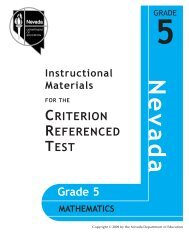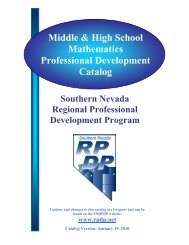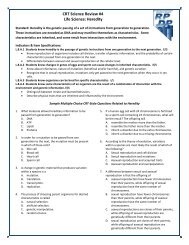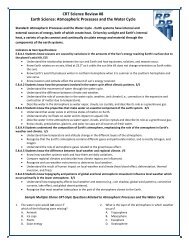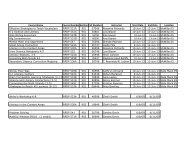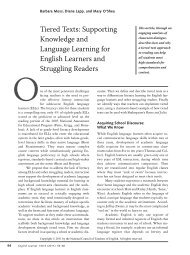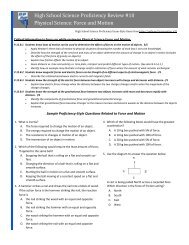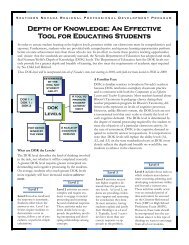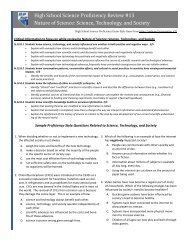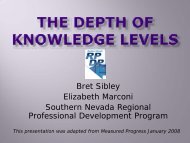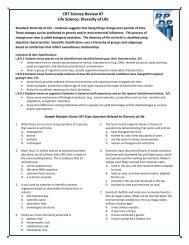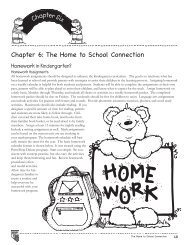Download - RPDP
Download - RPDP
Download - RPDP
You also want an ePaper? Increase the reach of your titles
YUMPU automatically turns print PDFs into web optimized ePapers that Google loves.
Getting Students to Think<br />
Scientifically: Concept<br />
Mapping and Interactive<br />
Notebooks<br />
by Doug Lombardi<br />
For deep learning of scientific concepts,<br />
students must develop the abilities to<br />
understand and monitor what they do and<br />
do not know. In other words, we must teach<br />
students to think about their thinking, an<br />
idea that is commonly called metacognition.<br />
When students engage in metacognition, they<br />
are self-assessing their understanding. But<br />
teaching metacognitive knowledge (What have<br />
I learned?) and monitoring (How can I assess<br />
what I have learned?) must not occur as an<br />
independent exercise; there is far too much<br />
content that our students must know in order to<br />
gain scientific literacy and successfully achieve.<br />
It is critical that the student self-assessment be<br />
embedded within the science content we teach.<br />
The good news is that we can inject learning<br />
about metacognition into our science lessons<br />
with some simple, but effective, instructional<br />
strategies.<br />
Scientific Reasoning<br />
In our science classes, we must increase<br />
metacognitive awareness of scientific reasoning.<br />
Specifically, we need to get our students to think<br />
like a scientist. But how do scientists think and<br />
reason?<br />
Scientists are essentially experts in solving<br />
problems. Of course, solving problems is<br />
not unique to science, but scientists tend to<br />
approach problem solving using a framework<br />
for thinking. Furthermore, this framework is<br />
centered on fundamental scientific principles.<br />
For example, when considering a force and<br />
motion problem, a scientist would first think<br />
about the relevance of Newton’s Laws and their<br />
connection to understanding how objects move<br />
and react. On the other hand, students would<br />
tend to solve the problem by first finding the<br />
right equations (e.g., F = ma) and then figuring<br />
out how they could use the equation to get an<br />
answer (Anzai, 1991). Essentially, scientists<br />
solve problems by organizing their thinking<br />
around the Big Ideas that dominate their areas<br />
of research, whereas students solve problems<br />
based on superficial information.<br />
Organizing Thinking Around the Big<br />
Ideas of Science<br />
If we want to move students towards organizing<br />
their thinking around the big ideas of science,<br />
they need strategies to help them with their<br />
metacognitive understanding and monitoring.<br />
Two effective strategies are the use of concept<br />
mapping and interactive science notebooks.<br />
Concept Mapping<br />
Concept mapping can be used often during the<br />
course of the school year as a way for students<br />
to preview, review, and assess their conceptual<br />
understanding. Furthermore, concept mapping<br />
is an excellent tool for students to gauge how<br />
these concepts are linked with big science<br />
ideas. Within the first few days of school,<br />
students should experience concept mapping<br />
by reviewing the major concepts they have<br />
learned in previous years. For example, in the<br />
Clark County School District, most high school<br />
freshmen are enrolled in Principles of Science.<br />
Employing concept mapping at the beginning<br />
of the year will allow students to explore the<br />
connections between the big ideas they have<br />
learned in middle school life, Earth, and physical<br />
science. The figure below is a simple example<br />
showing how the big science idea of energy is<br />
linked to within these content areas.<br />
The concept map shown above is really a web,<br />
with the central idea in the center. To develop



